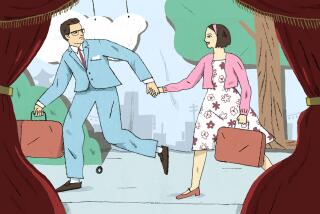A Coupleâs Struggle in the Aftermath of Traumatic Brain Injury
âWhere Is the Mango Princess?â is a chronicle of the life, âdeathâ and rebirth of Alan Forman, who was hit by a speedboat on vacation and suffered severe brain damage. A successful lawyer with a literary background, Alan emerged from the hospital scarred and changed forever. His neurotic edginess was gone. He was no longer interested in esoteric foreign films. His expectations, as well as his conversation, were simpler. And, like many survivors of traumatic brain injury, he was an enigma to his wife, Cathy Crimmins, who found herself suddenly living with a stranger. âThe âoldâ Alan died on July 1, 1996,â she writes, âand a new one arose, created by the rivers and lakes of bruises that coursed over his brain . . . .â
It is a stirring, lyrical comment about her husbandâs transformation, through calamity, into a different person. But as is true of many memoirs of illness, the transformation extends to her as well. The dominant focus of âWhere Is the Mango Princess?â is not a patientâs overcoming obstacles, although this is an important part of the story, but how illness forces spouses, often quite painfully, to undergo a similar rebirth in spirit as they care for their stricken loved ones.
About 2 million people are traumatically brain-injured every year, Crimmins writes, usually from car crashes in which seat belts werenât worn. On vacation in Canada, a speedboat plowed into a skiff carrying Alan, striking him in the head with as much force as if he was thrown through âa windshield at 70 miles per hour.â Crimmins describes it all, from her first sight of Alan (âsplayed across the stern . . . strangely motionless except for an occasional rapid jerk of a leg or armâ) to the agony of having this tragedy paraded past vacationers and busybodies on the way to the hospital.
In the days after the accident, Alan lay comatose as doctors struggled to stop the bleeding and swelling of his brain. CT scans showed that Alanâs problem was âglobal,â bruises and hematomas covered his frontal lobe, which controls speech and movement. The doctors didnât know what would happen.
Miraculously, Alan awoke a few days later. But Crimmins confesses that having him in a coma was easier to handle. For he was no longer the same person; he looked at Crimmins and the world with a mystified expression. Even though she had been âa hands-off wife,â soon she was feeding him, bathing him, coping with his memory loss.
Alan also lost his inhibitions as he recovered: He frequently cursed, and, to her horror, masturbated in front of nurses, visitors, even their 9-year-old daughter Kelly. Crimmins soon realized that her brilliant husband was gone: âI once had a husband who was doing a dissertation on Samuel Beckett, who had a thing for obscure Japanese cinema. . . . I canât imagine being married to a man who wonât be able to discuss books or go to the theater with me.â Instead, he was like a character invented by Beckett, muttering enigmatic statements and questions, such as the one that gives the book its title.
It is a little known-fact, Crimmins reports, that only about 5% of couples stay together after traumatic brain injury. It is no wonder, because in addition to personality changes and mood swings, the battles with HMOs and the ignorance of people who donât understand (brain injury is âthe hidden disabilityâ) conspire to ruin any hope of peace at home.
When he finally returned home, Alan seemed âperpetually stoned,â Crimmins writes, easily fatigued and disoriented by even slight rearrangements of the furniture. âI miss his dark side,â she says. âNow I wince as he chortles over mediocre cartoons. He has the personality of a sightly loony backslapping salesman.â
Sex and love, too, were problems in the weeks after his return. Their bodies connected, Crimmins writes heart-rendingly, but their hearts remained apart: âI try to look into his eyes, but thereâs nothing there.â But later, as he recovered, Alan reached out to Crimmins with shy, sincere demonstrations of affection. He surprised her with a sappy sentimental birthday card: âItâs funny how oneâs expectations can change: I cherish the amount of initiation it took for him to remember me and set aside a moment . . . to buy the card,â she writes, noting that the old Al would never have given this card, unless he meant it to be ironic.
Watching Alanâs struggle to rejoin the work force, Crimmins found a man determined to regain his dignity. His milder personality also showed her why their friends âfind Alanâs new softness more appealing. He has no defenses. He is an open book. . . .â
It is extremely moving to read how Crimmins learns to cherish her husband all over again, especially if one remembers how this memoir began. The fateful vacation had been botched from the start; Alan and Cathy had a bitter fight as they were packing the car. Then, the night before the accident, Alan asked her to go for a boat ride and look at the moon. What did she do? Like all people, blameless because no one has a gift for seeing the future, she wanted to sleep instead. That missed opportunity, she says, will always haunt her.
As a writer with a flair for humorous twists, Crimmins leavens her harrowing account with healthy doses of wit. She also admits that her family is lucky. Very few brain-injury victims ever recover to Alanâs level. âWhat we have . . . is a reasonable facsimile of our old life,â she writes near the end. Yet âWhere Is the Mango Princess?â also speaks to a much larger audience than just fellow survivors and their families.
This touching little memoir urges each of us to cherish every detail of our lives, especially when it comes to a choice between an extra hour of sleep and a moonlit boat ride.
More to Read
Sign up for our Book Club newsletter
Get the latest news, events and more from the Los Angeles Times Book Club, and help us get L.A. reading and talking.
You may occasionally receive promotional content from the Los Angeles Times.








